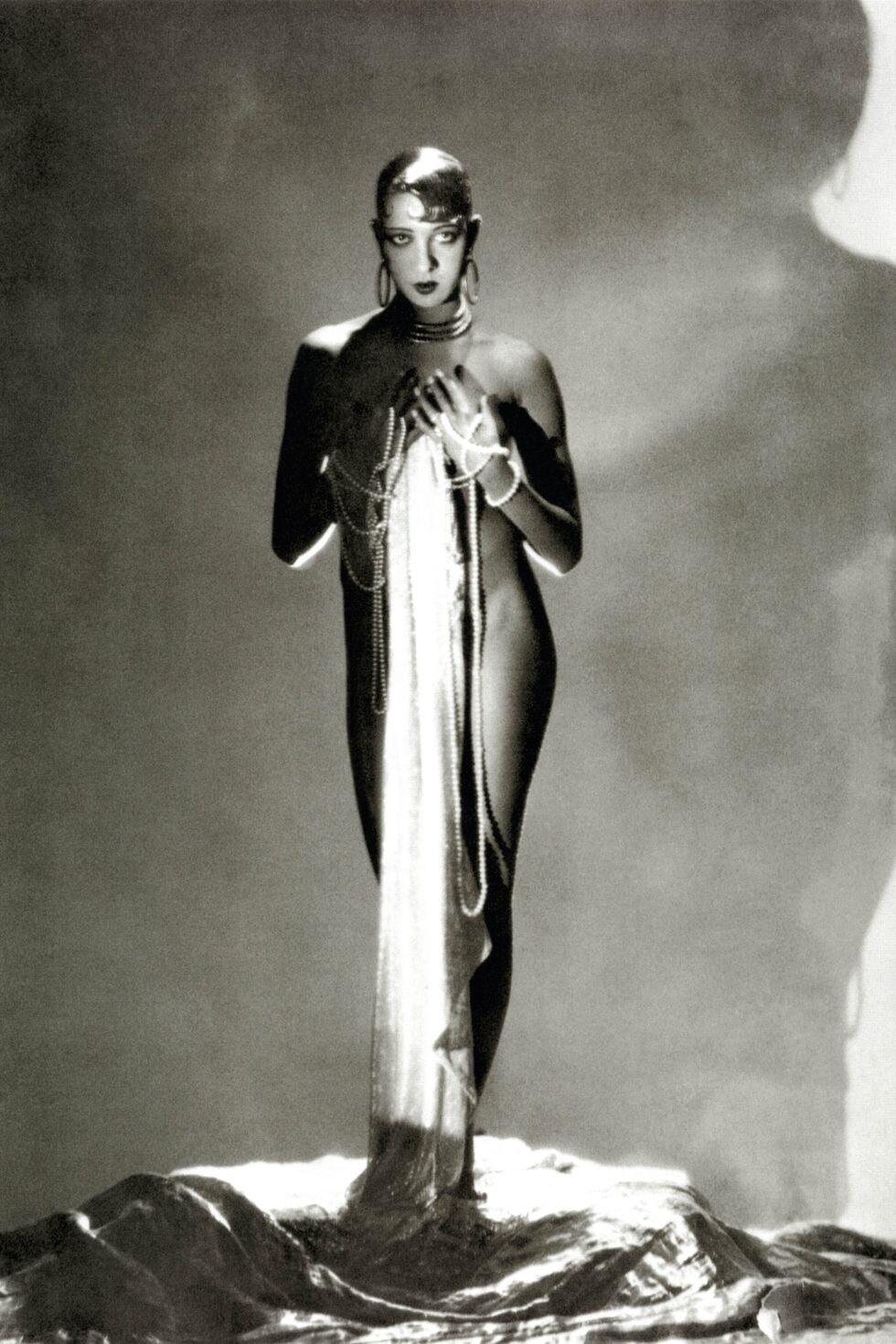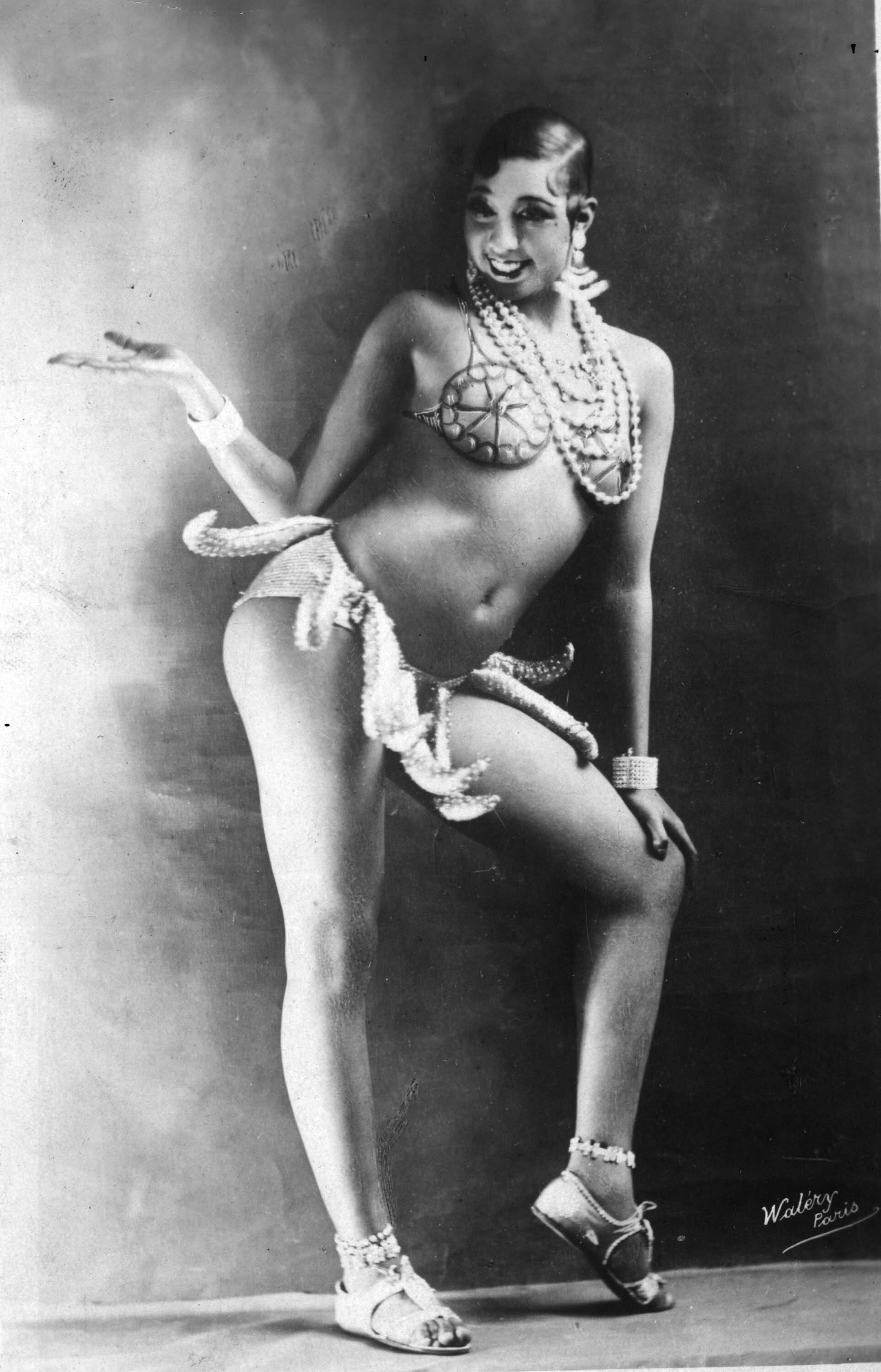Words by Roxy Bourdillon
In this week’s LGBTease: Queeroes Of Burlesque, we celebrate the Black, bisexual cabaret superstar who fought racism and the Nazis.
CW: racism
Josephine Baker is doing the splits, naked except for a strategically placed pink ostrich feather, lying upside down on the back of her male dance partner. She sure knows how to make an entrance. The year is 1925 and the 19-year-old chorus girl from St Louis is making her Paris debut in La Revue Nègre.
Sliding off Joe Alex’s nearly nude form, she slowly cartwheels onto the stage of the Théatre des Champs-Élysées. The atmosphere is electric and La Baker is mesmerising, vivacious and sensationally erotic. She dances using her whole body: shimmying, undulating, gyrating. The high society audience can’t believe what they’re seeing. Some are so shocked they pull their furs tightly around their shoulders and leave outraged. Others stay transfixed, whooping and hollering for more, more, more of “La Danse Sauvage”.
Josephine herself will later recall, “Driven by dark forces I didn’t recognise, I improvised, crazed by the music, the overheated theatre filled to the bursting point, the scorching eye of the spotlights. Even my teeth and eyes burned with fever. Each time I leaped I seemed to touch the sky, and when I regained earth it seemed to be mine alone.”
That night she was the toast of Paris: “Black Pearl”, “Bronze Venus”, “Creole Goddess”.
She would go on to be the most famous, photographed, talked-about woman in the world. Just stop and think about that for a second. A Black, bisexual woman from the slums of St Louis became one of the biggest celebrities of the twentieth century. Talk about trailblazing. As 1920s dance critic André Levinson wrote, “With Miss Josephine Baker everything seems to change.”
But before there was a legend, there was a little girl. In 1906, Freda Josephine McDonald was born, the illegitimate daughter of a washerwoman and the granddaughter of formerly enslaved people. From the age of eight, she worked as a domestic servant and was abused by her white employers. In 1917, she witnessed the horrors of the East St Louis riots. This white-led massacre, in which more than 100 Black people were murdered, had a profound effect on her lifelong dedication to the civil rights movement.
By the time she was 15, she had already been married twice. She divorced both husbands, but kept the second one’s surname. After all, Josephine Baker had such a nice ring to it. Determined to make it in showbiz, she danced her way from the Black vaudeville circuit on the streets of St Louis to the blinding lights of Broadway during the Harlem Renaissance. Her irrepressible pizazz made her “the highest paid chorus girl in the world”.
But as a woman of colour living under America’s Jim Crow segregation laws, she knew her career couldn’t progress any further on that side of the Atlantic, so she set sail for Paris in search of freedom, fame and pink ostrich feathers.
In a 1974 interview with The Guardian, Baker remembers, “I just couldn't stand America and I was one of the first coloured Americans to move to Paris. Oh yes, Bricktop was there as well. Me and her were the only two, and we had a marvellous time. Of course, everyone who was anyone knew Bricky. And they got to know Miss Baker as well." Bricky’s real name was Ada Smith. She was a renowned entertainer and self-proclaimed “saloon-owner”. The two women were lovers for a time and remained close friends. In the biography, The Hungry Heart, she comments, “Josephine was gorgeous, I mean naked or with clothes”.
Wide-eyed Josephine was immediately enraptured by the City of Love. “What did I see first? Men and women kissing each other in the streets! In America, you were sent to prison for that! This freedom amused me…. In the theatres, women could show themselves without clothing. I could not believe it, so I bought dozens of pictures of nude women.”
While there were no segregation laws in the French capital, there was still racial tension and Josephine’s arrival coincided with a nationwide obsession with Black culture.
White folks were listening to jazz, collecting African artworks, and learning how to Charleston. This new craze had disturbing undertones, particularly because of the widely held belief that Black people were “primitive”.
Josephine parodied this troubling cliché when she headlined the Folies Bergère in 1926. Picture the scene. The theatre is transformed into a tropical jungle complete with giant palm trees and hanging vines. A beautiful woman descends from the sky, wearing nothing but a G-string and 16 rubber bananas. She begins to dance and the audience erupts. In constant motion, she grinds her hips and shakes her bum, causing all those yellow phalluses to bounce about wildly.
When asked about the meaning of this act she says, “It represents slavery, discrimination and liberation. All of it is there, in the songs and dances.”
Whether this aesthetic subverted or reinforced racial stereotypes is debated by performers and academics to this day. What’s certain is that she did what she felt she had to do to get herself onto some of the most prestigious stages in the world. And once she was up there, she was breathtaking. Josephine performed her signature number all over Europe and was finally a bonafide superstar.
Embracing her newfound fame, she lived increasingly lavishly. She collected expensive jewels, marriage proposals, and a menagerie of pets including parakeets, a pig named Albert and a cheetah called Chiquita, who wore a diamond collar and roamed the stage of the Folies Bergère. She had weekly columns in newspapers and was photographed in all the fashion magazines. Thousands of dolls wearing banana skirts were sold across the continent.
She even launched her own cosmetic line featuring a skin-darkening lotion, Bakerskin, and hair pomade, Bakerfix. She used the cash to buy a nightclub, Chez Josephine, and her dream home - a literal fairytale castle - the 24-room Château des Milandes in the South of France.
Her career was still going strong in the late 1920s. The highest paid performer in Europe, her fans included Pablo Picasso and Ernest Hemingway. She began singing (if you’re looking for a new bisexual anthem, check out J’ai Deux Amours). She made herstory as the first Black movie star in 1927’s Siren Of The Tropics. But when the Second World War came, Josephine took on a new role, that of showgirl-turned-spy.
Joining the French Resistance, she declared, “The Parisians gave me their hearts, and I am ready to give them my life.” As a secret agent, she concealed weapons and Jewish refugees in her chateau. She smuggled messages in invisible ink on her sheet music and stashed photographs of military operations in her lingerie. Officials were so flustered at meeting the Josephine Baker, they didn’t bother to do a proper search. When you think about it, erotic dancers really do excel at espionage.
Josephine’s life story is remarkable, but what’s especially striking is how she used her success for the greater good.
In addition to taking on the actual Nazis, she campaigned for racial equality and refused to perform to segregated audiences. In an effort to prove that people of different races could co-exist peacefully, she adopted a dozen children from various countries and called them her “Rainbow Tribe”. In 1963, she returned to America to join Martin Luther King for the March On Washington. Overcome with emotion, she told the crowds, “I want you to know that this is the happiest day of my entire life… Seeing you all together is a sight for sore eyes. You’re together as salt and pepper, just as you should be, just as I’ve always wanted you to be.”
As well as providing groundbreaking representation for people of colour, Josephine was a potent symbol of sexual liberation and a bisexual icon.
She had four husbands and countless sweethearts, male and female. Discussing their time together in New York, performer Maude Russell explains, “We had girl friendships, the famous lady lovers, but lesbians weren’t well accepted in show business, they were called bull dykes. I guess we were bisexual, is what you’d call it today.” In The Hungry Heart, Josephine’s son Jean Claude lists many of his mother’s female partners, including blues singer Clara Smith, dancer Mildred Smallwood and Bessie Buchanan, the first Black person to hold a seat in the New York State Legislature. She clearly had a thing for high-achieving hotties. There was also a rumoured romance with Mexican artist Frida Kahlo (which I pray to the queer goddesses really happened) and a confirmed affair with openly bi writer and performer, Colette. When quizzed about the nature of their relationship Josephine revealed, "Colette loved me very much. I used to visit her after work on summer nights."
The magnificent Josephine continued to perform until 1975, when she died in her sleep aged 68, 50 years after her Paris debut.
The world mourned the loss of a legend, the French government honoured her with a 21-gun salute and over 20,000 people flooded the streets of Paris to watch her funeral procession.
There was no-one quite like Josephine. Her influence can still be seen today in the plethora of tribute acts from performers including Australia’s own Zelia Rose. Even Beyonce has paid homage, donning a bejewelled banana skirt for the 2006 Fashion Rocks event. Perle Noire, whose stage name is an ode to Josephine, shares her view on the Burlesque Undressed documentary: “She saw that people wanted it. They wanted to see a jungle woman and she gave them a jungle woman. ‘If you want jungle, I’m gonna give you jungle, but grand.’ … And when I do the banana dance I feel proud. I don’t feel demeaned. I feel proud.”
Josephine was a true original and a visionary. With her unapologetic eroticism, she showed women that they could embrace their sensuality. With her incredible professional success, she paved the way for other performers of colour. And with her bravery, she spent her whole life fighting for racial equality. She harnessed her star power to try and make the world a more loving place.



